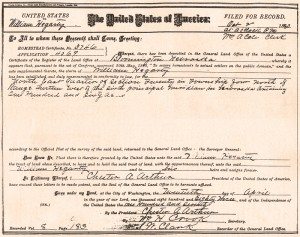Early Settlers
The first settlers to come to the Campbell area, selected land along or just beyond the Little Blue River, This was their lifeline; it provided their fuel, water, and in some cases, logs for their homes.
The first land law of 1800 enabled the frontiersmen to purchase public domain lands, but there was a constant demand for easier terms or even free land. This was realized with the passage of the Homestead Act on May 20, 1862. This act provided that “any person who is the head of a family, or who has arrived at the age of twenty-one years, and is a citizen of the of the United States, or who shall have filed his declaration of intention to become such” could obtain one hundred and sixty acres of land or 80 acres if within a railroad grant area.

Filed Oct. 2, 1883, Homestead Certificate No. 3746 granted to William Hegarty. Authorized by President Chester A. Arthur the "North East quarter of Section Twenty in township from north of range thirteen west of the sixth principal meridian in Nebraska containing One Hundred and sixty acres."
The initial cost of the $14.00 was to be paid when filing a claim. The settler was allowed six months to establish a home and make improvements. He was obliged to make this his permanent residence for five years, at which time, he could apply for his patent. “Proving up” entailed an additional fee of $4.00 and two witnesses to verify that he had made the required Improvements.
Anyone arriving before the summer of 1874, filed their claims at the U.S. Land Office in Lowell, Ne. in the northeast corner of Kearney County. The land office was moved to Bloomington in May, 1874.
Railroad land was available for purchase because this area was in a railroad grant area. In general, they owned the odd numbered sections, 20 miles on each side of the railroad right away. In the 1970’s, this land was selling for an average of $2.00 per acre. All of Burlington’s holdings in Nebraska were sold and paid for by 1905.
If the railroad was to be a financial success, it was imperative that this land be sold quickly. Potential users of the rail service were the farmers, and merchants in the railroad’s planned towns and villages. For this reason, the railroad offered easy terms on all land. One-tenth of the purchase price was required for a down-payment and interest only, usually 5%, was required for the first three years. Credit was for 10 or 11 years and cash land sales were discounted 25%.
The railroad companies carried on a promotional campaign to colonize the area. Agents were sent to Europe and Canada to promote settlement. An early ad reads “$25.45 round trip from Chicago to Lincoln.” If the individual purchased land, the fare was deducted from the purchase price. Special immigrant trains moved families and their belongings at below-cost rates.
Dozens of war-weary soldiers came to this area in the 1870’s. Among them were Byron Burt, Leander Miller, Gilbert Orcutt, Nathan Hart, Henry Beck, Cyrus Culbertson, Wash Fulton, Samuel Hardy, Henry Ross, Frank Warrick and others, some of whom, are in the family section of this book.
The Civil War veterans were given land warrants as a reward for their service in the war. Time spent in service was credited to their proving up time and they were allowed 160 acres within the limit of the railroad rightaway; non veterans could obtain only 80 acres.
Thus, the earliest settlers were a composite of home-seekers from the Old World and Canada, native born and soldier. Though many left before “proving up”, many remained and withstood the conflict and hardships of the raw prairie. By the time the village was founded in 1886, nearly every quarter was inhabited.
Some of the earliest families who remained and did not submit histories were William Goldbach, brother-in-law of Nelson Burg, who came from Michigan in 1876 and bought 160 acres from the railroad for $1.50 an acre. Their daughters married early businessmen, William Aultz’s sons: George, who married Barbra Goldbach and John who married her sister, Ida. Will Patterson came in the 1870’s and homesteaded the NW 1/4 of Section 9, Harmony Twp. They had two sons, Briton and Earl; and two daughters Leona and Alta. Earl remained on his father’s homestead and lived out his life here.
